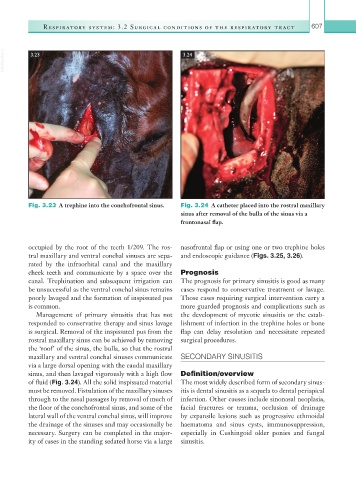Page 632 - Equine Clinical Medicine, Surgery and Reproduction, 2nd Edition
P. 632
Respir atory system: 3.2 Surgical conditions of the respir atory tr act 607
VetBooks.ir 3.23 3.24
Fig. 3.23 A trephine into the conchofrontal sinus. Fig. 3.24 A catheter placed into the rostral maxillary
sinus after removal of the bulla of the sinus via a
frontonasal flap.
occupied by the root of the teeth 1/209. The ros- nasofrontal flap or using one or two trephine holes
tral maxillary and ventral conchal sinuses are sepa- and endoscopic guidance (Figs. 3.25, 3.26).
rated by the infraorbital canal and the maxillary
cheek teeth and communicate by a space over the Prognosis
canal. Trephination and subsequent irrigation can The prognosis for primary sinusitis is good as many
be unsuccessful as the ventral conchal sinus remains cases respond to conservative treatment or lavage.
poorly lavaged and the formation of inspissated pus Those cases requiring surgical intervention carry a
is common. more guarded prognosis and complications such as
Management of primary sinusitis that has not the development of mycotic sinusitis or the estab-
responded to conservative therapy and sinus lavage lishment of infection in the trephine holes or bone
is surgical. Removal of the inspissated pus from the flap can delay resolution and necessitate repeated
rostral maxillary sinus can be achieved by removing surgical procedures.
the ‘roof’ of the sinus, the bulla, so that the rostral
maxillary and ventral conchal sinuses communicate SECONDARY SINUSITIS
via a large dorsal opening with the caudal maxillary
sinus, and then lavaged vigorously with a high flow Definition/overview
of fluid (Fig. 3.24). All the solid inspissated material The most widely described form of secondary sinus-
must be removed. Fistulation of the maxillary sinuses itis is dental sinusitis as a sequela to dental periapical
through to the nasal passages by removal of much of infection. Other causes include sinonasal neoplasia,
the floor of the conchofrontal sinus, and some of the facial fractures or trauma, occlusion of drainage
lateral wall of the ventral conchal sinus, will improve by expansile lesions such as progressive ethmoidal
the drainage of the sinuses and may occasionally be haematoma and sinus cysts, immunosuppression,
necessary. Surgery can be completed in the major- especially in Cushingoid older ponies and fungal
ity of cases in the standing sedated horse via a large sinusitis.

